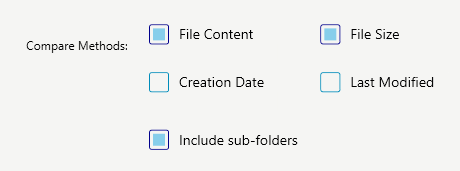Home___Download___FAQ___Version History___Purchase___User Manual___Support
Folder Compare Software
Compare your Source Folder and Target Folder for similarities and differences. Get a detailed report of the same files, different files, and additional files in each folder with DupInOut Duplicate Finder.
What is a Folder Compare Software?
Folder Compare software (also called Folder Comparison tool or Folder Comparer) is a comprehensive file management software that compares the contents of two or more folders and reports similarities and differences between the files, sub-folders, and folder structures. It provides a side-by-side comparison of the folders to help you review the similarities and differences and export the data to a file for future reference.
Benefits of Using a Folder Compare Software
Compare Source & Destination Folders
The tool provides a complete overview of all files in two folders, including the same files, different files, and additional files in the source and destination folders.
Validate Copied Files
Once you have copied your files to another folder, you'll want to verify that all the files were successfully transferred and that no files were left behind during the process.
Check the Integrity of Important Documents
You have backed up your important files to another location. After a month, you want to validate that your original files have not been changed, corrupted, or modified by someone else.
Validate Synced Files
If you’re using Microsoft OneDrive or a similar file-syncing service, you might want to occasionally validate that all your files are synced.
Export Compare Report to a File
You can also export the same files, different files, and additional file lists to a Comma-separated Value (.csv) file for information purposes.
Process Files
After saving your folder comparison report to a structured format like a Comma-separated Value (.csv) file, you may use Command Prompt, Windows PowerShell, or other tools to process your files.
Different Metrics of Folder Comparison
A Folder Comparison tool supports multiple metrics. You can use one metric in isolation; or multiple metrics in combination. It’s up to you.
File Content
File Content is one of the strong and accurate metrics of comparison. It generates the hashes of each file in the source and target folders and compares hashes of the files from the source folder with those in the target folder in a hierarchical manner.
A hash is a fixed-size string that represents the content of data. A hash is usually non-reversible, which means you cannot get back the original data from a hash value. Files with the same hash value are considered the Same Files, and those with varying hash values are considered the Different Files. Nevertheless, if a file is larger, the Scan Engine may take longer to generate the hash.
File Size
File Size is considered a quicker way to gauge differences between files. It can report files with the same size as “Same Files” and those with varying sizes as “Different Files”. Nonetheless, when employed in isolation, file size might not serve as a precise comparison metric.
Creation Date-Time
File Creation date-time is a metric that takes the chronological order of files for comparison. It identifies the same files and different files based on the date and time when they were created. It flags files with the same creation date-time as the Same Files, and those with different date-time as Different Files. When employed in isolation, it can be a less dependable metric of comparison. This is because the file date-time can be altered using third-party tools. Also, file copying and file restoring activities often change the original timestamps, leading to incorrect results.
Modification Date-Time
Much like the Creation Date-Time metric, the File Modification date-time takes the chronological order of file comparison. It reports the same files and different files based on when they were last modified (either by the user or by the system/ application). File Modification Date-Time is also a less dependable metric of comparison for the same reasons as the Creation Date-Time metric.
How to Compare Folders Using a Folder Compare Tool? (Simple Steps)
Step 2: Choose Comparison Metrics
Specify the metrics you want to use for comparing files from the source folder to those in the destination.
You can check one or more comparison metrics of your choice, such as File Content, File Size, Creation Date, and Last Modified. For the highest accuracy, it is suggested to check the File Content and File Size options together.
Step 3: Start Folder Comparison
Click on the Compare button to start the folder comparison process. Depending on the size and number of files, it may take some time to compare your files.
Once your Source and Target folders are compared, the information will be split into multiple tabs, viz. Same Files, Different Files, Folder 1 Only, and Folder 2 Only.
You can also export the file lists to a Comma-separated Value (.csv) file for your reference.
© Copyright Vikas M. All Rights Reserved.
DupInOut Duplicate Finder is a duly registered copyrighted work in accordance with the provisions of the Indian copyright law and is protected by the copyright law in India and other countries. Any unauthorized use, redistribution of this software and/ or its source code without prior written permission from the owner is strictly prohibited.
Microsoft, Windows are registered trademarks of Microsoft Corporation in the U.S.A. and other countries.



